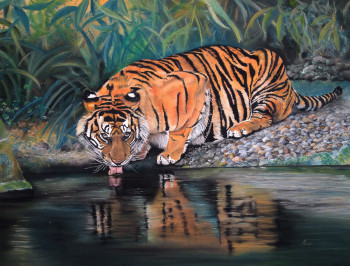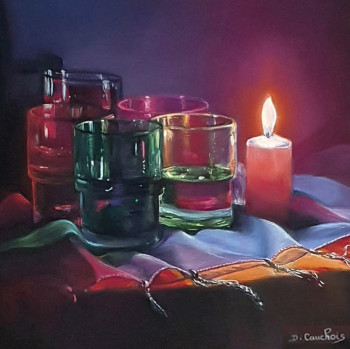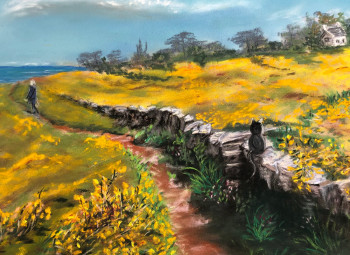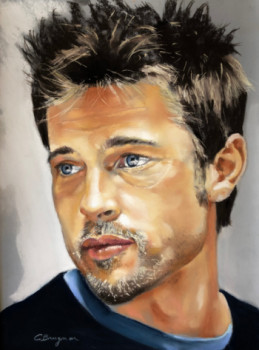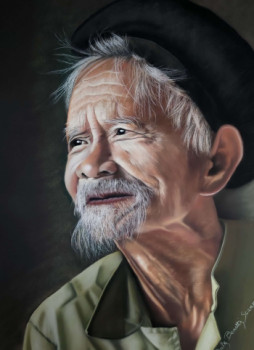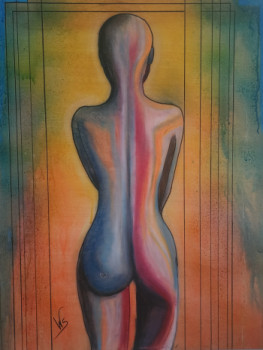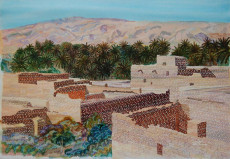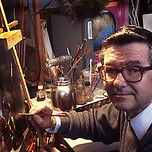
Pastel painting
Pastel art is a complex drawing technique that offers original, subtle and unique results.
History of pastel painting
The pastel technique has been used by artists since the Renaissance. Leonardo da Vinci used it and gave it its letters of nobility. He appreciates in this process the fact of being able to give relief to the works. However, it was later in the 18th century that painters specialized in this discipline. A big name from this era associated with this know-how is Quentin de la Tour(...).
After them, many impressionists such as Mary Cassatt, É Douard Manet, Edgar Degas were also seduced by pastel. Then the Nabis with Édouard Vuillard.
In the 19th century the names of Lucien Lévy-Dhurmer and Jeanne Jacquemin stand out ;stain.
At the beginning of the 20th century, Simon Bussy distinguished himself in this technique, notably by representing animals. From the 1950s onwards the technique seemed less used.
In the 1980s, art historian Jean Clair hoped for a return to art. this practice which he considers to reveal virtuosity. and subtlety.
What is pastel paint?
Pastel is a small colored stick used in painting. in painting and drawing. The sticks are composed of:
- Pigments to give color: either mineral, organic, or vegetable
- A base made of chalk or plaster which gives the pastel its texture
- A binder which allows for consistency and hardness. of the stick. This is gum arabic for dry pastels, and oil or wax for oil pastels.
The pastel technique
This technique is similar to; both in drawing and painting.
It can be close to the technique of charcoal through drawing from lines and shading. But also the pictorial approach in the superposition of more or less thick layers of color. The range of pastel effects is very wide.
The painter can use the sticks in different ways:
- with the side the finest pastel for precise lines
- with the edge for working surfaces
- but also crushed in order to obtain a colored powder
The gestures and the work of the hand, the fingers, in a more or less forceful manner allows a profusion of lines and textures. This technique stimulates the emotions and provokes feelings of purity. and color vibration. The artist can use pure color sticks but also mixes of colors by superposition or fusion.
pastel painting works
- Self-portrait with a lace frill, Quentin de la Tour, 1751
Master of the pastel technique, the painter is one of its masters. He particularly excelled in pastel portraits. When he created this self-portrait, he was at the height of his art. Its dimensions are 65X53 cm.
Quentin de la Tour shows himself here placed three-quarter view. He wears a powdered wig, a ponytail and a blue garment decorated with gold. with a lace jabot. It is anchored in the light. His lips form a smile. He looks at the viewer in a communicative attitude.
The colors used here are cold colors, of which blue tones are dominant.
Pastel allows the painter to work with materials and give suitable for both satin and velvet effects. The light glides over the surfaces thus created and gives a feeling of life.
This self-portrait brilliantly depicts an affable, flourishing, successful artist.
- After bathing, naked woman wiping her neck, Degas, 1898
This work is one in a series of drawings made with pastel and ink. oil by Degas, on the theme of women bathing. Its dimensions are 103.5 × 98.5 cm.
In this pastel painting, the artist has drawn a woman sitting on a wicker armchair on which white towels are placed. She turns with her back turned; to the viewer. His body is tilted, almost twisted. The eyes are drawn to the accentuated features of the spine. The woman dries her neck with one of the towels. She seems to come out of the bathtub drawn at the back of the room. The other arm rests on the back of the chair. Around her, the space is delimited; by vertical and diagonal lines.
Here, the pastel is very worked. It thus creates deep textures. It is also used to make blurred contours. This technique allows you to emphasize the movement of the character.
- Mother and child on green background, Mary Cassatt, 1897
The artist, friend of Edgar Degas, shares his taste for drawing and pastel painting. She cherishes the work of the line with this technique.
Mary Cassatt chooses women and children as her favorite subject of study. She uses softness and sensuality to pastel to paint for her maternity scenes or those with babies and young children. The velvety of the skin is admirably rendered. She transposes into everyday life the themes studied in previous centuries in the works of Virgins to Mary. the child.
Mary Cassatt brilliantly uses the ways of drawing with color: either leaving the gesture visible, with incisive strokes, or in a more blurred and rounded way.
She takes up the tradition of pastel from the 18th century, the era of the success of artists such as Maurice Quentin, and brings it up to date by studying the theme of motherhood. It highlights and colors a new relationship between women and children. She uses the subtleties of pastel to bring out the intimacy of the painting. and the tenderness of his portraits.
Pastel painting is therefore an artistic technique that has gone through many generations. centuries and is particularly suitable for the staging of colors and the creation of a special atmosphere.
